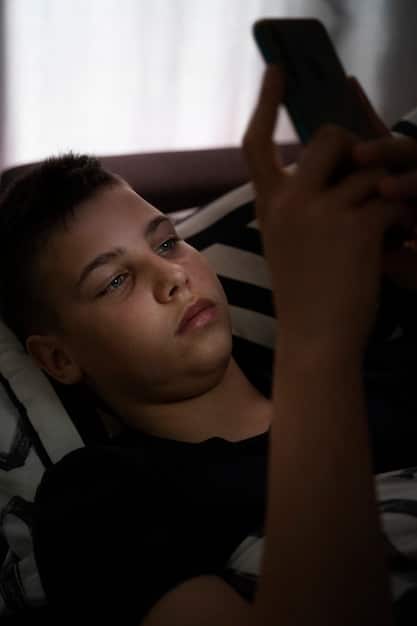Break Free: Overcoming Social Media Addiction in 30 Days

Social media addiction can significantly impact mental health and daily life; this guide provides actionable strategies to identify the signs of addiction and implement a 30-day plan to regain control and achieve a healthier relationship with social platforms.
In today’s digital age, social media platforms have become deeply ingrained in our daily routines, offering connection, entertainment, and information at our fingertips. However, the excessive use of these platforms can lead to a phenomenon known as social media addiction, characterized by compulsive engagement, loss of control, and negative impacts on various aspects of life. If you’re finding it hard to disconnect, this guide provides a structured approach to recognizing the signs of addiction and taking meaningful steps to break free in just 30 days.
Recognizing the Signs of Social Media Addiction
Understanding the signs of social media addiction is the first critical step toward addressing the issue. Addiction manifests in various ways, impacting both your mental and physical well-being, as well as your social interactions and productivity. Recognizing these indicators can empower you to acknowledge the problem and begin the journey toward recovery.
Increased Usage and Preoccupation
One of the primary signs is a significant increase in time spent on social media platforms. You may find yourself constantly checking your phone, scrolling through feeds, and engaging with content for hours each day. This behavior often leads to preoccupation, where social media dominates your thoughts and becomes the first thing you think about in the morning and the last thing at night.
Negative Impact on Daily Life
Social media addiction can also negatively affect your daily life by disrupting your sleep patterns, causing eye strain, and reducing physical activity. You might neglect your responsibilities, such as work, school, or personal hygiene, in favor of spending time online. This imbalance can create stress and anxiety, further fueling the addictive behavior.
- Neglecting Responsibilities: Prioritizing social media over important tasks or obligations.
- Sleep Deprivation: Staying up late to scroll, resulting in fatigue and reduced cognitive function.
- Reduced Productivity: Difficulty focusing on work or studies due to constant distractions from social media.
- Physical Health Issues: Experiencing eye strain, headaches, or neck pain due to prolonged screen time.
Recognizing these signs is crucial. If you identify with several of these indicators, it may be time to evaluate your social media habits and consider taking steps to regain control. Awareness is the first step toward breaking free from social media’s grip.

The Psychological Impact of Social Media Addiction
Beyond the observable behaviors, social media addiction has profound psychological effects. It can contribute to feelings of inadequacy, depression, and anxiety. Understanding these impacts is essential for addressing the root causes of your addiction and developing coping strategies.
Comparison and Low Self-Esteem
Social media platforms often present idealized versions of reality, leading individuals to compare themselves to others. This comparison can result in feelings of inadequacy, low self-esteem, and body image issues. The constant exposure to curated content can create an unrealistic standard that is difficult to attain.
Fear of Missing Out (FOMO)
FOMO is another significant psychological consequence of social media addiction. The fear of missing out on experiences, events, or trends can drive compulsive engagement with social media. This anxiety can lead to excessive checking of notifications and a constant need to stay connected, further reinforcing addictive behaviors.
- Increased Anxiety: Feeling anxious or stressed when unable to access social media.
- Depression: Experiencing feelings of sadness, hopelessness, or worthlessness due to social media comparisons.
- Reduced Life Satisfaction: Feeling less satisfied with real-life experiences compared to curated online content.
- Social Isolation: Spending more time online than engaging in face-to-face interactions, leading to feelings of loneliness.
Recognizing these psychological impacts can help you understand the depth of the problem and motivate you to seek healthier habits. Remember, social media often presents a distorted view of reality, and it’s essential to prioritize your mental well-being over online validation.
Setting Realistic Goals for a 30-Day Detox
Embarking on a 30-day detox is a significant step toward breaking free from social media addiction. Setting realistic goals is vital to ensure success and avoid discouragement. Start by defining what you hope to achieve during this period, whether it’s reducing your screen time, improving your mental health, or rediscovering offline hobbies.
Define Your Objectives
Before starting your detox, take some time to reflect on why you want to change your social media habits. Are you hoping to improve your sleep, reduce anxiety, or reconnect with real-life relationships? Clearly defining your objectives will provide you with the motivation and direction needed to stay committed to your goals.
Start Gradually
Avoid trying to quit cold turkey, as this can often lead to relapse. Instead, start by gradually reducing your time on social media each day. Set specific limits for each platform and use tools or apps to track your usage. Slowly decreasing your engagement will make the detox process more manageable and sustainable.
- Track Your Usage: Use apps or device settings to monitor how much time you spend on social media daily.
- Set Time Limits: Decide on a specific amount of time you’ll allow yourself on each platform and stick to it.
- Designate Social Media-Free Zones: Establish certain times or locations where you won’t use social media, such as during meals or in the bedroom.
- Reward Your Progress: Celebrate small victories along the way to stay motivated and positive.
By setting realistic objectives and taking a gradual approach, you can increase your chances of successfully completing your 30-day detox and establishing healthier social media habits.

Implementing a Daily Plan to Reduce Social Media Use
To effectively break free from social media addiction in 30 days, you’ll need to implement a structured daily plan. This plan should include strategies to minimize triggers, create alternative activities, and develop coping mechanisms for dealing with urges.
Minimize Triggers
Identify the situations, emotions, or times of day that trigger your social media use. Once you’re aware of these triggers, take steps to avoid or minimize them. For example, if you tend to scroll through social media when you’re bored, find alternative activities to occupy your time.
Create Alternative Activities
Fill the void left by social media with engaging and fulfilling activities. Rediscover hobbies you once enjoyed, try new ones, or focus on spending quality time with friends and family. Engaging in these activities will provide you with a sense of purpose and satisfaction, reducing your reliance on social media for entertainment and validation.
- Engage in Physical Activity: Exercise releases endorphins, which can improve your mood and reduce stress.
- Spend Time in Nature: Connecting with nature can have a calming effect and provide a break from digital stimulation.
- Practice Mindfulness: Mindfulness techniques can help you stay present and manage urges to use social media.
- Connect with Loved Ones: Nurture your real-life relationships by spending quality time with friends and family.
A well-structured daily plan can help you stay on track and make steady progress toward breaking free from social media addiction. Remember to be patient with yourself and celebrate your achievements along the way.
Developing Coping Mechanisms for Cravings and Urges
During your 30-day detox, you’ll likely experience cravings and urges to use social media. Developing effective coping mechanisms is essential for managing these challenges and staying committed to your goals. These mechanisms should include both short-term strategies for immediate relief and long-term approaches for sustained change.
Short-Term Strategies
When you feel an urge to use social media, try engaging in a distracting activity, such as reading a book, listening to music, or going for a walk. These activities can help you temporarily divert your attention and reduce the intensity of the craving. You can also practice deep breathing exercises or mindfulness techniques to calm your mind and body.
Long-Term Approaches
In addition to short-term strategies, it’s crucial to develop long-term approaches for managing cravings and urges. This may involve addressing underlying issues, such as anxiety or depression, that contribute to your social media addiction. Seeking support from a therapist or counselor can provide you with valuable tools and insights for overcoming these challenges.
- Practice Delayed Gratification: Train yourself to resist the immediate urge to use social media and wait for a set period of time.
- Identify Underlying Issues: Explore potential emotional or psychological factors contributing to your addiction.
- Seek Social Support: Connect with friends, family, or support groups to share your experiences and receive encouragement.
- Develop Self-Compassion: Be kind and understanding toward yourself, especially when you experience setbacks.
By combining short-term and long-term coping mechanisms, you can effectively manage cravings and urges and stay on track with your 30-day detox. Remember, it’s okay to ask for help and seek support when you need it.
Maintaining a Healthy Relationship with Social Media After Detox
Completing your 30-day detox is a significant accomplishment, but it’s essential to maintain a healthy relationship with social media moving forward. This involves setting boundaries, being mindful of your usage, and prioritizing your mental and physical well-being.
Setting Boundaries
Establish clear boundaries for your social media use. Set specific times each day when you’ll allow yourself to engage with these platforms and stick to these limits. Avoid using social media before bed or first thing in the morning, as this can disrupt your sleep and increase anxiety.
Mindful Usage
Be mindful of the content you consume and the interactions you engage in on social media. Unfollow accounts that trigger negative emotions or promote unrealistic standards. Focus on engaging with content that is positive, uplifting, and informative. Remember that social media is just one aspect of your life, and it shouldn’t dominate your thoughts or feelings.
- Limit Screen Time: Continue to monitor and limit your daily social media usage.
- Curate Your Feed: Unfollow accounts that make you feel negative or inadequate.
- Engage Mindfully: Be selective about the content you consume and the interactions you participate in.
- Prioritize Real-Life Interactions: Dedicate time to nurturing your real-life relationships and experiences.
Maintaining a healthy relationship with social media requires ongoing effort and self-awareness. By setting boundaries, being mindful of your usage, and prioritizing your overall well-being, you can enjoy the benefits of these platforms without falling back into addictive patterns.
| Key Point | Brief Description |
|---|---|
| 📱 Recognize Signs | Identify increased usage, negative impacts on life, and psychological effects. |
| 🎯 Set Goals | Define objectives and start gradually reducing social media time. |
| 📅 Daily Plan | Minimize triggers and engage in alternative, fulfilling activities. |
| 🛡️ Coping Mechanisms | Use short-term distractions and long-term strategies to manage cravings. |
FAQ
▼
Key signs include increased time spent on social media, neglecting responsibilities, experiencing anxiety when unable to access platforms, and comparing yourself to others online.
▼
Define clear objectives for your detox, such as improving sleep or reducing anxiety. Start gradually by reducing your social media time each day, rather than quitting cold turkey.
▼
Engage in physical activity, spend time in nature, practice mindfulness, or reconnect with loved ones. These activities can provide fulfillment and reduce reliance on social media.
▼
Use short-term distractions like reading or listening to music. Address underlying issues and seek social support to manage long-term cravings effectively.
▼
Set clear boundaries for your social media use, be mindful of the content you consume, and prioritize your mental and physical well-being to avoid falling back into old habits.
Conclusion
Overcoming social media addiction is a journey that requires awareness, commitment, and the right strategies. By recognizing the signs of addiction, setting realistic goals, implementing a daily plan, and developing coping mechanisms, you can reclaim control of your life and foster a healthier relationship with social media. The 30-day detox is not just about abstaining from these platforms; it is about rediscovering yourself and your passions beyond the digital world.





